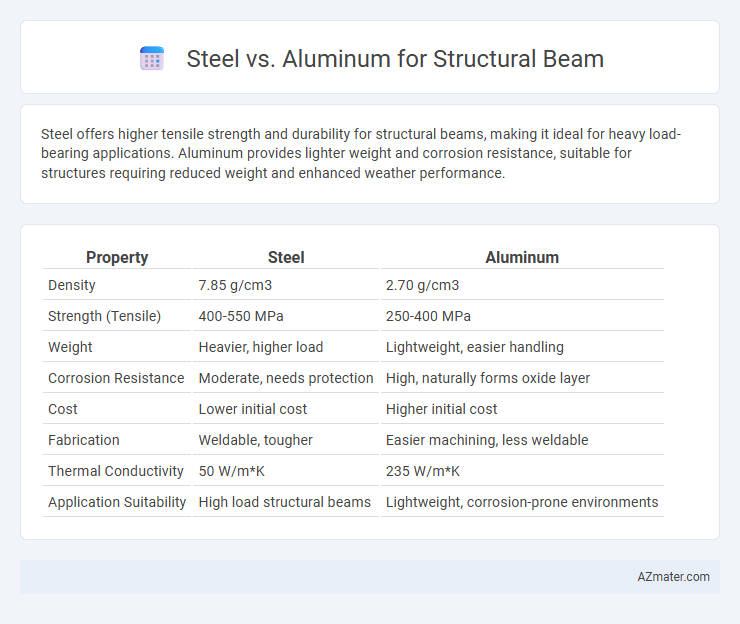Steel offers higher tensile strength and durability for structural beams, making it ideal for heavy load-bearing applications. Aluminum provides lighter weight and corrosion resistance, suitable for structures requiring reduced weight and enhanced weather performance.
Table of Comparison
| Property | Steel | Aluminum |
|---|---|---|
| Density | 7.85 g/cm3 | 2.70 g/cm3 |
| Strength (Tensile) | 400-550 MPa | 250-400 MPa |
| Weight | Heavier, higher load | Lightweight, easier handling |
| Corrosion Resistance | Moderate, needs protection | High, naturally forms oxide layer |
| Cost | Lower initial cost | Higher initial cost |
| Fabrication | Weldable, tougher | Easier machining, less weldable |
| Thermal Conductivity | 50 W/m*K | 235 W/m*K |
| Application Suitability | High load structural beams | Lightweight, corrosion-prone environments |
Introduction to Steel and Aluminum Beams
Steel beams offer high strength, durability, and load-bearing capacity, making them ideal for heavy structural applications in construction and infrastructure. Aluminum beams are lightweight with excellent corrosion resistance, suitable for projects requiring ease of installation and reduced structural weight. Both materials provide unique benefits, with steel favored for strength-intensive environments and aluminum chosen for weight-sensitive designs.
Material Properties Overview
Steel offers high tensile strength and excellent durability, making it ideal for structural beams requiring heavy load-bearing capacity and resistance to deformation. Aluminum provides a lightweight alternative with good corrosion resistance and moderate strength, suitable for applications where reducing overall weight is critical without compromising structural integrity. Both materials exhibit distinct thermal conductivity and fatigue resistance characteristics, influencing design choices in construction and engineering projects.
Strength and Load-Bearing Capacity
Steel offers significantly higher tensile strength and load-bearing capacity compared to aluminum, making it ideal for heavy structural beams in construction. Its superior yield strength allows steel beams to support greater weights and resist deformation under heavy loads. Aluminum, while lighter and corrosion-resistant, has lower strength, requiring larger cross-sections to match the load-bearing capacity of steel beams.
Weight and Density Comparison
Steel has a density of approximately 7850 kg/m3, making it significantly heavier than aluminum, which has a density around 2700 kg/m3. The lower density of aluminum results in lighter structural beams, reducing overall weight and easing transportation and installation. However, steel's higher density contributes to greater strength and load-bearing capacity despite its increased weight.
Corrosion Resistance and Durability
Steel structural beams offer superior strength and durability but require protective coatings to resist corrosion effectively, especially in harsh environments. Aluminum beams provide excellent corrosion resistance due to their natural oxide layer, making them ideal for applications exposed to moisture and chemicals, though they typically have lower load-bearing capacity than steel. Choosing between steel and aluminum depends on balancing corrosion resistance needs with structural performance requirements and maintenance considerations.
Cost Analysis and Budget Considerations
Steel structural beams generally have a higher initial material cost compared to aluminum but offer greater strength and durability, potentially reducing long-term maintenance expenses. Aluminum beams, while more expensive upfront per pound, are lighter, which can lower transportation and installation costs, making them cost-effective for projects with weight constraints. Budget considerations must account for lifecycle costs including fabrication, transportation, installation, and maintenance to determine the most economical choice between steel and aluminum beams.
Fabrication and Installation Differences
Steel structural beams offer high tensile strength and can be easily welded or bolted during fabrication, allowing for precise customization and strong, durable joints. Aluminum beams are lighter, enabling faster maneuvering and installation on-site, but require specialized welding techniques such as TIG welding due to their higher thermal conductivity and lower melting point. Fabrication of aluminum beams demands careful handling to avoid warping and requires protective coatings to prevent corrosion, while steel beams benefit from standard fabrication processes and greater resistance to deformation during installation.
Environmental Impact and Sustainability
Steel structural beams exhibit higher recyclability rates, with up to 90-95% of steel being recycled, reducing landfill waste and conserving natural resources. Aluminum beams require significantly less energy during production, approximately 5-10 times less than steel, which lowers greenhouse gas emissions and supports sustainability goals. Both materials offer durability, but aluminum's lighter weight contributes to reduced transportation emissions and overall environmental impact in construction projects.
Common Applications for Each Material
Steel structural beams are widely used in skyscrapers, bridges, and industrial buildings due to their high strength, durability, and load-bearing capacity. Aluminum beams are preferred in applications requiring lightweight construction, such as aircraft hangars, marine structures, and temporary frameworks, where corrosion resistance and ease of installation are critical. Both materials serve distinct roles in construction, with steel dominating heavy-duty projects and aluminum excelling in environments demanding reduced weight and enhanced corrosion protection.
Choosing the Right Material for Your Project
Steel offers superior strength and durability, making it ideal for heavy-load structural beams where maximum support is critical. Aluminum boasts a lightweight advantage with excellent corrosion resistance, suitable for projects prioritizing ease of installation and longevity in harsh environments. Evaluating project requirements such as load-bearing capacity, environmental exposure, budget constraints, and fabrication needs ensures the optimal choice between steel and aluminum beams.

Infographic: Steel vs Aluminum for Structural Beam
 azmater.com
azmater.com